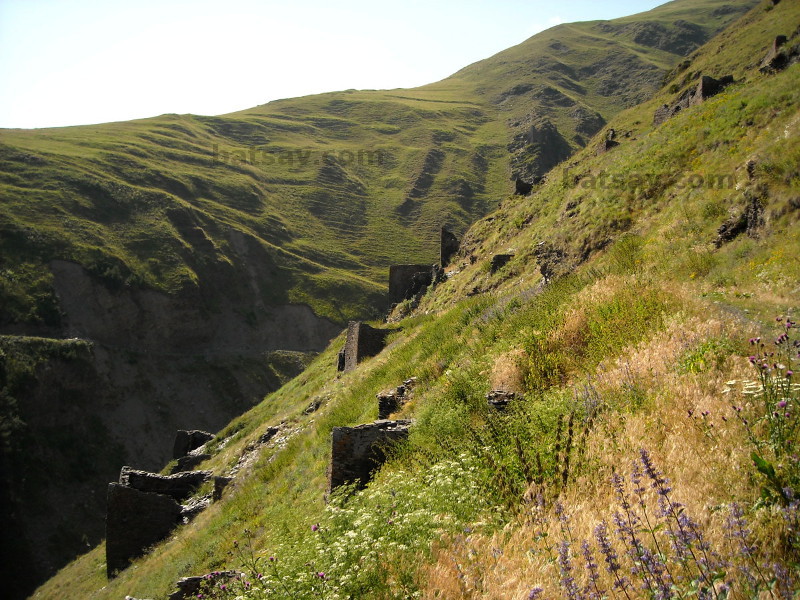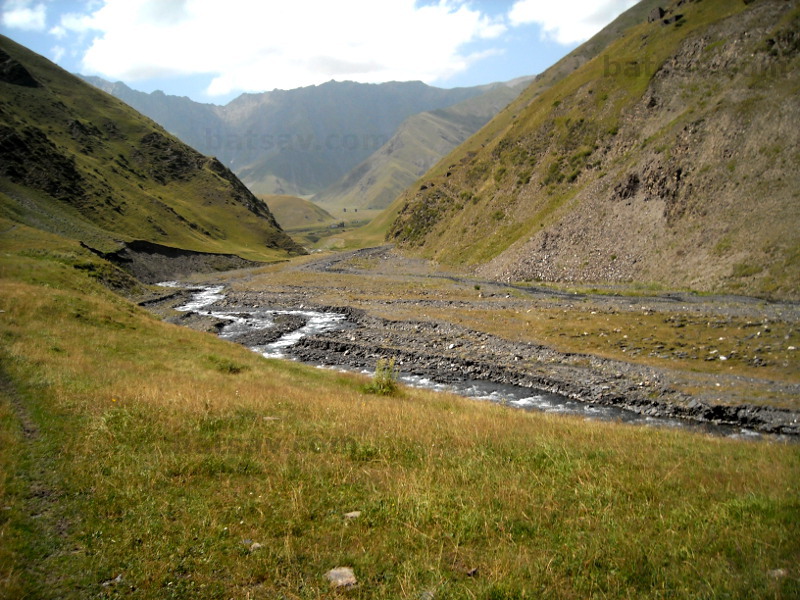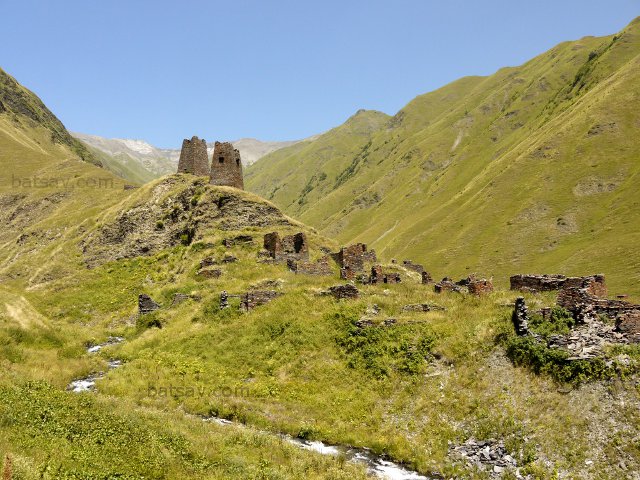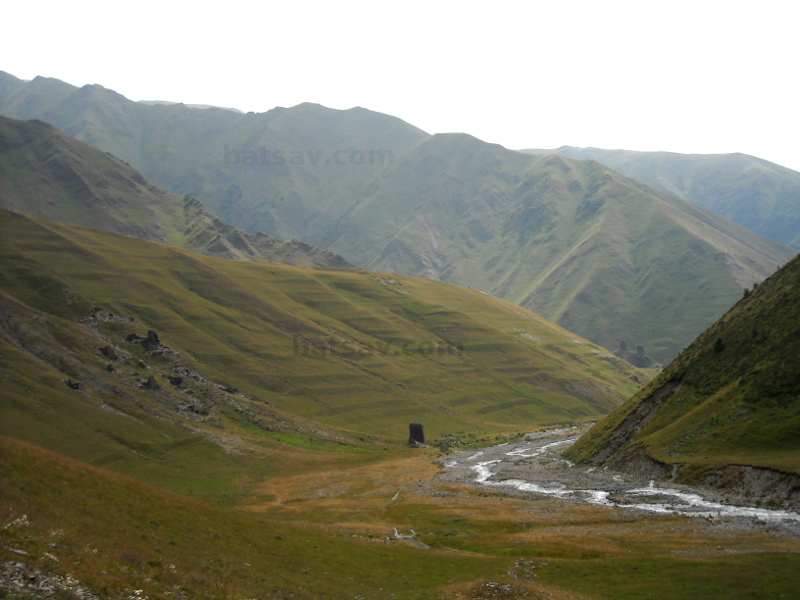Who are the Batsbi?
This website aims to collect and publish information on the myriad peoples of the Caucasus,
particularly the highlanders of northern Georgia (e.g. the Khevsurs, the Pshavs, the Tush, the Mtiuls, &c., &c.),
but its main concern is with the Batsbi or "Bats people".

|
* |
* |
* |
|---|
Who?
The Batsbi are one of the four historical communities of Tusheti, a mountainous region of north-eastern Georgia. These communities, each made up of around a dozen villages and hamlets, are named after the valleys they inhabit:
— the villages of the "Gometsari" Tush in the valley of the Tushetis Alazani River;
— the "Pirikiti" from the valley of the Pirikitis Alazani River;
— the "Chaghma" from the Chaghma Basin (around Omalo); and
— the "Tsova" from the gorge of the Tsovatistsq'ali River (a tributary of the Tushetis Alazani).
The Batsbi—whose language, Batsbur mot', points to a probable Nakh origin (i.e. related to the Chechens and the Ingush)—are believed to have migrated to the Tsova Gorge in the XVIIth century. There they settled, living in eight fortified villages typical of the region until the early XIXth century, when they abandoned their homes and moved down to the plain of Alvani at the western end of Kakheti, where they live to this day.
In Tusheti and in Georgia as a whole, they are also known—if indeed they are known at all—as the Tsova or Tsova-Tush (Georgian: წოვა; singular წოვა–თუში, "tsova-tushi", plural წოვა–თუშები, "tsova-tushebi"), i.e. 'the Tush from the Tsova Gorge' (as opposed to those from the Gometsari or Pirikiti Valleys or the Chaghma Basin).
The Batsbi are thus one of the four historical communities of Tusheti, yet they are profoundly different from the other three by virtue of their language, Batsbur, a Nakh i.e. North-eastern Caucasian or "Nakh-Daghestanian" tongue, entirely unrelated to the Georgian dialect spoken by their neighbouring communities.
|
* |
* |
* |
|---|
Where?
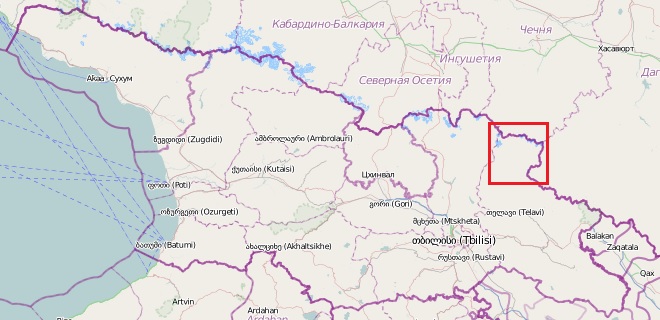
A map of Georgia showing Tusheti
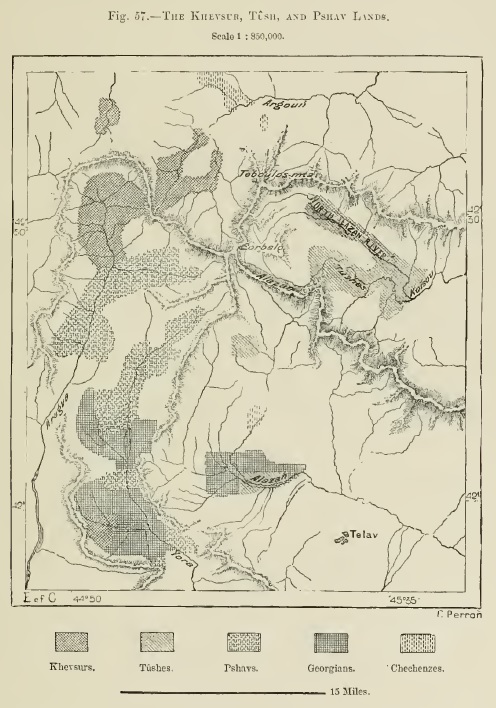
Élisée Reclus' map of the Khevsur, Tush and Pshav lands
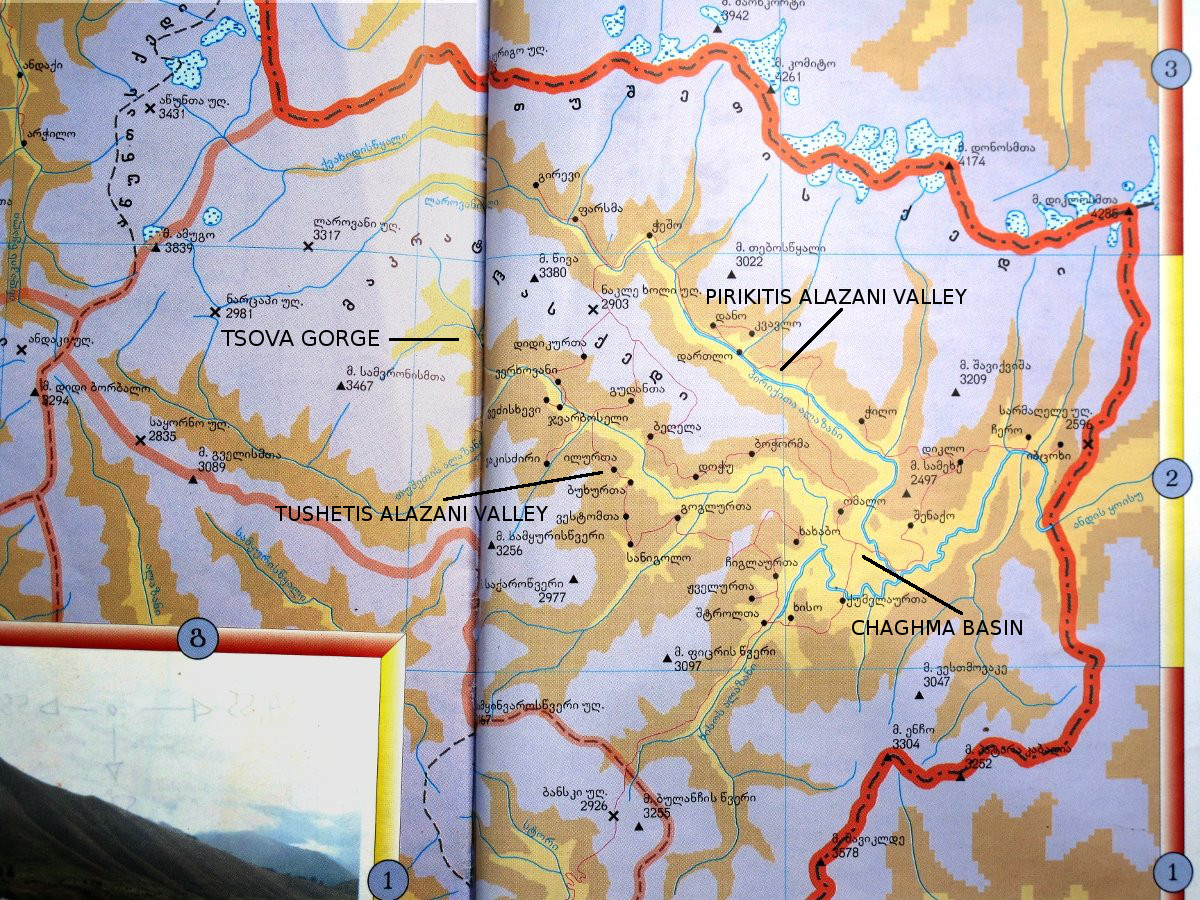
An annotated map of Tusheti (please click for a larger image)
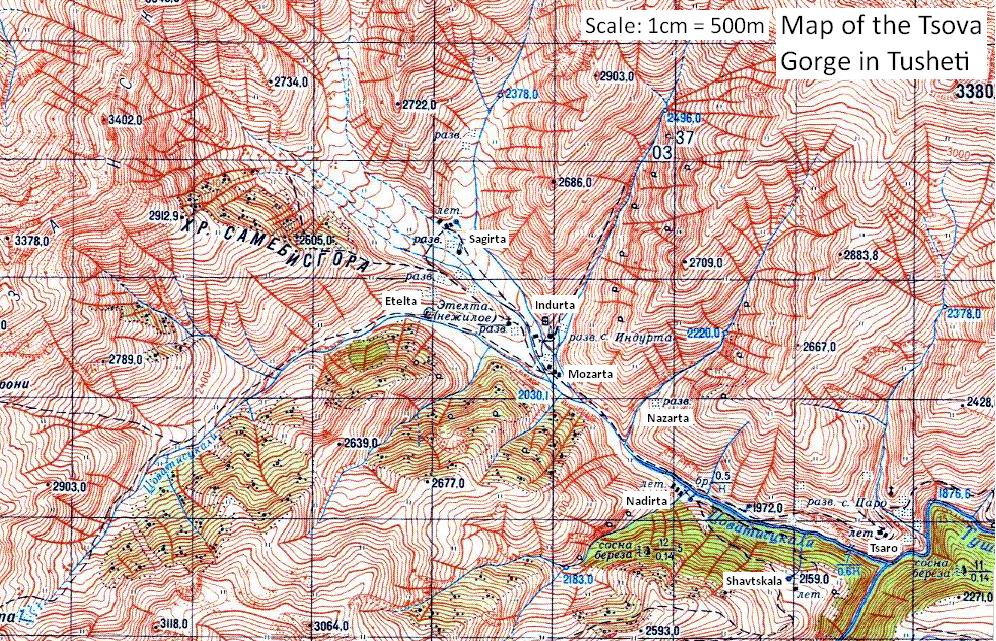
The 8 villages of the Tsova Gorge (please click for a larger image)
This detail was taken from the Red Army's excellent 1:50,000 topographic survey:
see this page for more
|
|
|
|---|---|
|
|
|
|
* |
* |
* |
|---|
The Wikipedia entry (link) on the Batsbi sums up the problematic debate over their origins rather succinctly:
Debate over origins
The origins of the Bats are mysterious, with two prevailing views. As the Estonian scholar Ants Viires points out in his Red Book of the Peoples of the Caucasus [see below—A.B.], it is actually two separate disputes: the first being whether it was Nakh tribes or Old Georgians that inhabited Tusheti first, the second being from which (or both) the Bats are descended.
Descent from the Nakh tribes
The first is that they are descended from ancient Nakh tribes inhabiting the region. The Old Iberian name for the ancient inhabitants of Kakheti was "Kakh", but they apparently called themselves "Kabatsa" and they are thought to have been "Tushians of Nakh extraction" Jaimoukha notes that according to an 18th century Georgian historian named Vakhushti, the Kakh considered the Dzurdzuks (an old Georgian name for the Chechens), Kists (Georgian for the Ingush) and Gligvs (unknown origin, though some speculate it was another name for the Ingush as used by some authors) as their ethnic kin.
Descent from 16th century Ingush migrants
The second theory has it that the Batsbi crossed the Greater Caucasus range from Ingushetia in the seventeenth century and eventually settled in Tusheti, and that they are therefore a tribe of Ingush origin which was christianized and "Georgianized" over the centuries.
However, this latter theory is somewhat awkward with regard to the fact that, linguistically, the Bats language (within the Nakh family) is much more distinct from Chechen and Ingush than they are from each other, having differentiated from them much longer ago than the 15th century (when Chechen and Ingush began differentiating, approximately), and forms a completely different branch. However, this does not necessarily render the theory to be non-plausible.
Over the centuries, the Batsbi have to some extent been "Georgianized" by their neighbours the Tush (a Georgian mountain people—themselves probably a mixture of Georgian, Nakh and possibly "Daghestanian"), and by the time the Batsbi abandoned their mountain fastnesses and moved down to the more favourable climes of Georgia's eastern province of Kakheti, in the lowlands, they were bilingual in both Batsbur (their unique language, closely related to Chechen and Ingush) and Georgian, and had adopted much of Tush i.e. Georgian, Kartvelian culture.
Several thousand of them still live in the village of Zemo Alvani in western Kakheti (close to the provincial town of Akhmeta) where their great-great-grandfathers settled around 200 years ago, but their cultural assimilation into the wider Tush and Georgian community is almost consummated. Their individuality is destined to disappear within a few more generations.
Their language—batsbur mot—still (just) exists, and is still spoken by many of those over 50 years old who remained in the village. The young, however, have not learnt Batsbur, and the old have—generally-speaking—not taught it, for both groups have little interest or reason (beyond principle) to do so. Despite some vague attempts to introduce Batsbur language classes for the children in school, nothing much has been done.
Their identity—as Batsbi—is also fading fast, and little remains of their individuality. To the few Georgians who have heard of them, they are Tush, and even those Batsbi who are aware of any slight differences between themselves and their neighbours do not proclaim any "original" North Caucasian identity and think of themselves as Georgians.
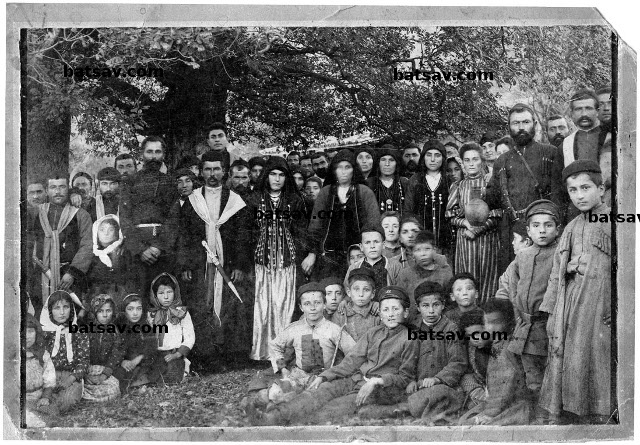
A (late XIXth century?) photograph of a Batsbur wedding
For more information on the Batsbi, I suggest you read a very interesting article written by Prof. Roland Topchishvili, which I have reproduced here on my website (No. 14 in "Resources and Links").
The Red Book of the Peoples of the Caucasus has a rather good i.e. relatively speaking quite complete entry on the Batsbi (link):
THE BATS
Self-designation. They call themselves batsba nah (Bats people), and their language batsba motjiti (Bats language). Neighbouring peoples, who speak the Nakh languages (Ingushes, Chechens), know them by the same name. The peoples who speak the Kvartelian languages (Georgians, Sans, Svans) know the Bats as tsova-tushians and the Didos call them tsuv-ak.
The Bats language belongs to the Nakh group of the Caucasian languages. There are no dialects of Bats and neither is there a written from—the Bats use Georgian as their literary language.
Until the middle of the 19th century the Bats lived in Tushetia, the mountain region of Northwest Georgia. The Tsova Gorge in Tushetia was inhabited by four Bats communities: the Sagirta, Otelta, Mozarta and Indurta. Later they settled on the Kakhetia Plain, in the village of Zemo-Alvani, where they still live. Administratively they are part of the Akhmeta district of Georgia. There are some families of Bats in Tbilisi and other bigger towns in Georgia.
No exact data exists concerning the exact population of the Bats. None of the censuses taken in the Soviet Union have counted them as a separate nation and they have been regarded as Georgians. According to the collection "The Languages of the Peoples of the USSR", which in its turn was based on the findings of the expeditions of the 1960s, the Bats number 2,500-3,000. Considering the tendency to assimilate, the number has probably declined since then.
Religion. The Bats are Christians. The first records of Christianity in Tushetia date from the 16th century, though the actual conversion could have taken place some centuries before. Christianity spread from Tushetia via the Bats to the Chechens and Ingushes. The strength of their faith manifested itself in a series of wars against the "non-believers", i.e. the Islamic peoples of Daghestan, as well as in strong opposition to the Islamization policy of Persia in the 18th century.
While it is an acknowledged fact that the Bats language belongs to the Nakh group of languages, there is no agreement on the Bats' ethnic origin. Numerous interpretations exist, but because of a lack of historical, ethnographic and anthropological material none can said to be definitive. There are two main areas of contention: a) were the first inhabitants of Tushetia Nakh or Old Georgian tribes? and b) from which do the Bats originate? For centuries there have been two communities next to each other in Tushetia, one speaking the Nakh language, the other Old Georgian. The general name for them is Tush, according to their language either Tsova- or Chagma-Tushian. They formed one single material and intellectual unit with Old Georgian elements prevailing.
The descendants of the Old Georgian pagan tribes, whose ancestors had fled from Christianity to Tushetia, are regarded as Tushians. In the mountains some of the fugitives splintered off from other Old Georgian tribes. They were in close contact with the Nakh tribes which resulted in a new linguistic unit.
According to the other hypothesis the Bats' ancestors are members of the Chechen Kist tribe who moved south and became isolated from their kindred tribes. Having contact with Old Georgian tribes they adopted their culture, but maintained their own language.
Anthropological research shows that the Bats or Tsova-Tushians are closer to Chagma-Tushians, holding an intermediary position between the Chagma-Tushians and Chechen Kist tribes.
Tushetia as a geographical unit is first mentioned in the 4th century BC. During the 12th--14th centuries it was a part of Georgia and after its collapse was absorbed into the kingdom of Kakhetia. In the 16th century Persia and Turkey became interested in Kakhetia and Tushetia. The next three centuries saw numerous fierce battles between Persia and Turkey, and the rulers of Kartli (Iberia) and Kakhetia, the overlords of the Tushians, constantly appealed for help to Russia. The Tushians played a significant role in the delegations sent to Russia. The Tushians also acted as negotiators between Georgia and the Chechens and Ingush. In 1762, King Irakli II managed to unite Kartli and Kakhetia and the new union, which also included Tushetia, was annexed to Russia in 1801. The event failed to ensure peace because in the middle of the 1800s the Tushians fought Shamil and muridism. As a result of these battles the central government in Russia came to regard the fighting skills of the Tushians very highly.
Before settling on the plains the Bats used to breed sheep. Sheep breeding required large mountain pastures and these were rented from the Chechens. Apart from the sheep, oxen and horses were also reared. Working the land was of minor importance, a situation which changed only in the second half of the 19th century after the Bats resettled to the plains. By the end of the 19th century the Bats were already using artificial irrigation and quite advanced fertilization and agricultural equipment. Sheep breeding still retained its prominence, because its products (cheese and wool) were the Bats' main exports. The are records of the Bats having trade relations with France and England, though generally goods were exchanged with other mountain nations in Georgia or with the Ingushes and Chechens. The Bats' homespun cloth achieved renown.
Historical records chronicle the Bats' striving for education. Education as well as folk traditions and culture were closely connected with corresponding Georgian institutions, especially with the Christian Church. The Bats consider Dmitri Tsiskarishvili, born in the 17th century, to be their first intellectual. He was educated at the Telavi and Tbilisi seminaries and later in the newly-founded St.Petersburg. By the 18th-19th century there were already several university graduates among the Bats. The year 1864 marked the beginning of a national education for the Bats with the opening of a primary school in the village of Zemo-Alvani. The languages used in teaching were Georgian and Russian, and amongst the subjects taught were biblical history, arithmetic and gymnastics. This movement toward education did not occur with Chagma-Tushians.
At the end of the 19th century nationalist and separatist ideas began to spread through Bats society, however their social movement took place within the limits of the disorders in Georgia and the whole of the Caucasus. The changes in central government in 1917 led to a period of confusion lasting for decades. The national independence movement was confronted by two imperialistic forces: the White Guard supporters of Denikin and the Bolshevist Red Army. The Bats were able to repel the White Guard but not the attack of the Bolshevist 11th army. Soviet power was established in Tushetia at the end of 1920 and the region was annexed to the Soviet Union on December 30th, 1922 as a part of the Trans-Caucasus Federation. The imposition of Soviet authority failed to bring about any stabilization in the political situation. Strong nationalist feelings were preserved in Tushetia and these were manifest in both active and passive opposition. Soviet rule was finally consolidated amongst the Bats at the end of the 1930s with the introduction of collectivization and the accompanying liquidation of all nationalists.
The first major changes in the Bats' national development were brought about as a result of their resettlement to the plains in the middle of the 19th century. New conditions brought about a new way of life and changes in the Bats economy. Georgian language and culture gained more importance. In the mountains the Bats had been living in keeping with common laws and national traditions. There had been a tendency towards becoming more and more Georgian but after the establishing of Soviet rule the Georgian influence became even stronger. This was accompanied by the centralization of the economy. The fate of the Bats was more often decided in offices in Moscow and Tbilisi than in their own villages. In the 1970s only half of the inhabitants of the village of Zemo-Alvani could speak Bats and even then it was only used at home. Communication in the main was in Georgian.
Bats society has been weakened also by the urbanization of the 1950s and 60s. Mixed marriages have become more common and everyday life and culture are now greatly affected by European urban culture and Soviet customs.
|
* |
* |
* |
|---|
Also of great interest are a pair of obscure commentaries in W.E.D. Allen's remarkable Russian Embassies to the Georgian Kings, 1589-1605 (the Hakluyt Society, Series II, No. 138, Cambridge: Cambridge University Press, 1970, pp. 288-289):
COMMENTARY 15: Metsk, Batsk (ref. Chap. 2, p. 111, n. 1)
'Dont la position est absolument inconnue' Brosset (EC/BHP/II, Nos. 14-15, col. 236). Some of the topographical indications of this passage are obscure but it would seem that the Georgians were proposing a route up the valley of the Argun, leading by tracks over the main chain of [the] Caucasus [mountains] into the upper valleys of the Aragvi and the Alazani. This route would cross the territory of the Akko Chechens (Shikh murza's Okok) who were friendly to the Russians and had a sloboda at Terek-town (see Introduction, Section 5 and Commentary 14). The villages of Upper and Lower Kii (Akki) lie on an affluent of the Tchanti (White) Argun, the westerly feeder of the Argun (Baddeley, RFC, Vol. II, index under 'Kii' and Map V, and for description of Argun route as far as the Tchanti Argun, ibid., Vol. I, pp. 90 ff.). West of the Tchanti Argun a track crosses the Basti-lam (lam = mountain, ridge, in Ingush), the boundary between Chechnya and Georgia (ibid., Vol. I, p. 114) to Shatil (1,524 m.) west of the great peaks of Tebulos-mta (4,494 m.); then by the Anatori Pass to Khamkheti and paths leading to the upper valleys of the Aragvi and the Alazani. From Shatil, Baddeley states, a ride to Tiflis 'in summer or early autumn' would always be feasible. Compare Radde's 'Marschroute', 1876, in Die Chews'uren und ihr Land, as far as Djarego on the Tchanti Argun. West of this river Meesti ridge or plateau is marked on Güldenstädt's map; it seems to correspond to Miskin-doukh of Baddeley's 'Map V'. Bronevski (Vol. II, p. 166) refers to an Ingush commune of Meesti, and also to the Aka and Betsi communes of the upper Kombulei. These indications explain the Metsk mountain range of Zvenigorodski. Amaley is the river Kombulei (Reineggs/W., Vol. I, p. 311; Bronevski, Vol. II, pp. 91, 152, 160), whose upper valley runs parallel with the Sunzha, the Assa and the Argun, and finally enters the Terek a few miles above Tartarup. Burnash remains obscure.
Reineggs/W. (Vol. II, p. 39), described the Basti as a sub-tribe of the Kists, then settled on the left bank of the middle Sunzha. They were neighbours of the Alti (cf. Baddeley, RFC, Vol. I, p. 79, for the commune of Aldee, famous as the base of Sheikh Mansur in 1785). These Basti may have been a fragment of an older Batsi agglomeration along the Sunzha. The Batsi (Georgian plur. Batsebi) were held to be Kists (Baddeley, RFC, Vol I, p. 90) who are related to the Chechens (Reineggs/W., Vol. I, p. 41). (Bronevski, Vol. II, p. 158, finds that the Kist language has some resemblance to Tush, and he believes therefore that the (Georgian) Tushes must be of Kist origin; it would seem here that he is in fact referring to the Batsi whose dialect has been much influenced by Georgian: see Desheriev.) In 1575 the communes of the Batsi in the tchanti-Argun district sought the protection of King Levan of Kakheti against the Avar nutsal; they were allowed to pasture their flocks in the highlands of upper Kakheti, south of the main ridge of [the] Caucasus [mountains] and south-east of the great peak of Tebulos-mta and the Kadowanis Pass (3,048 m.), where they mixed with the Tushes. During the last century they moved as far south as Akhmeti and Alvan on the Alazani (cf. Desheriev, Batsbiyski yazyk, and Radde, Chews'uren, pp. 330 ff., and map). For the suggestion that the Batsebi represent a surviving fragment of the classical Bessoi, see Karst, OM, p. 504; also Allen, 'Ex Ponto, I and II' in BK, No. 30/31 (1958), p. 51.
—
COMMENTARY 20(c): 'Soni-land' (=Sonskaya Zemlya): note on the ethnology of the eristavate of the Aragvi (ref. Chap. 3, p. 133, n. 2)
Neighbours of the Didos to the north-west were the Sodi of Pliny, VI, 10, whom Trever (Ocherki po istorii I kulture Kavkazskoy Albanii, Moskva, 1959, p. 202, n. 3) equates with the Tsavdi. There is a reference to the Tsavdi in the fifth century A.D. when they are bracketed with the Lipni or Lbini (Trever, p. 202), who are none other than the Lupeni of the classical authors (Trever, p. 48), a people perhaps to be identified with a wolf totem (cf. Commentary 41 for the cult of a black dog without spots surviving among the Didos).
The name Tsavdi corresponds to the Tsova of Wakhusht (Brosset ed., Description géographique de la Géorgie par le Tsarévich Wakhoucht publiée d'après l'original autograph par M. Brosset, St Petersburg, 1842, p. 327). It is possible to pinpoint the Tsavdi/Sodi from Wakhusht's account of Tusheti at the beginning of the eighteenth century (see Brosset's ed., pp. 327-9 and map 4—'Kakheth'). Tusheti is placed north of Mount Lopeti and the Lopotis-tsqali, clearly toponymic fossils of the old Lupeni, i.e. Lop-eti = the country of the Lup-en-i). The district lies on the flanks of the main chain where it forms the watershed of the Argun flowing north to the Terek and the Andi-koysu flowing north-east to the Sulak and the Caspian. Tusheti is divided into two valleys running from north-west to south-east. It has its own river (Tchanti-Argun on Baddeley's, The rugged flanks of Caucasus, Oxford, 1940, Map II where the place-name “Shoundee” still survives) which goes to join the Sona (here Argun) which crosses Tchatchan (Chechnia) and at Baraghan falls into the Terg (Terek). Tsova is beyond the Caucasus (i.e. south of the main ridge) in the direction of Pankisi; below Tsova is Gometsari, and lower down Tchaghma; from this last place the route leads to the valleys of Torga (cf. Commentary 28: The Village of Tog) and Lopoti: there are situated the principal villages of Tusheti but there are thirty-seven others. Of the remnants of the 'Tsoff' at the beginning of the twentieth century Baddeley, The rugged flanks of Caucasus, Vol. I, p. 90, observes that “amongst the Tousheens there is a whole community, known formerly by the name of Tsoff... which speaks a dialect of the Kist (Ingush) language and is, presumably, of Kist origin, though cut off from them as far back as history goes'.
Another group of these Sodi/Tsavdi/Tsova maintained their individuality into mediaeval times in the district of Sagaredzho, along the middle reaches of the Iori, since Janashvili, in his edition of Wakhusht (p. 104, n. 351), cites Kartlis-Tskhovreba, Vol. I, p. 239, for Sudzheti as an alternative name for Sagaredzho, naming the inhabitants Sudzhi or Sodzhi—forms which closely correspond to the classical Sodi.
Genko, Iz kulturnogo proshlogo Ingushey in Zapiski Kollegii Vostokovedov, Leningrad, 1930, p. 698, recalls that Tsiskarov, in his 'Notes on Tusheti' published in 1849 in the Tiflis journal Kavkaz, gives 'Vabua' as a second and ancient name of the original homeland of the Tsov who were then inhabiting the enclave among the Tush. He comments that 'there can be no doubt that the ancient Tsov name for Tsovata, Vabua, is identical with the tribal appellation of the Veppintsy (contemporary form fäppij) who were grouped around their ancient centre Erzi aul (Arzee on Baddeley's The rugged flanks of Caucasus, Map II)—on the river Arm-khi (Kistinka) which enters the Terek some versts below Old Lars'. According to the same author (p. 707), erziy (ärzij) is the Ingush word for 'eagle'—'in all probability an old Iranian loan-word'. This may be compared with the totemic implications of 'Tsounta' and 'Tsesi', see p. 315 above. In the present writer's view, the Veppintsy (fäppij) can be a remnant of the classical Bessi of Macedonia and the Psessoi of the Cimmerian Bosporus, a widespread ethnic group of very ancient origins: for refs. See Bédi Karthlisa, Nos. 30-1, article by Allen, 'Ex Ponto I: Heni-Veneti and Os-Alans', passim. To the same remote background belong the Soni/Sodi/Sonti/Tsavdi, who can be identified with the varying forms Heni in classical sources.
In the 'Conversion of Georgia', a record compiled in the tenth century and relating to events of the sixth century, the Daryal gorge is named the 'Tsanar ravine' (cf. Genko, p. 711). The identity of Tsanar (in Georgian Ts'anar with ejaculative ts') with Ptolemy's Zanarioi has been accepted by Minorsky (Hudūd al-'Ālam: 'The regions of the world', Oxford, 1937, pp. 400 ff.). Zan-ari-oi, in fact represents the root zan>son with the duplication of the Svanian plural in -ar and the Greek plural in -oi. 'In the ninth to tenth century A.D. the Tsanar are often identified with the Kakhs. Finally, the Georgian-speaking peoples entirely absorbed the Tsanar... As regards the nucleus of the Tsanar trible, N.Y. Marr (Izvestiya Rossiyskoy Akademii Nauk, 1916, pp. 1397-8), hinted at its common origin with the present-day Chechen. Such is also the opinion of A.N. Genko, the undisputed authority on that part of the Caucasus' (Minorsky, ibid., and Genko, 711).
Unless stated otherwise or obviously not the case, all the text and images on this website are © A.J.T. Bainbridge 2006-2015
Do get in touch! Gmail: alexjtb

